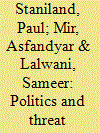|
|
|
Sort Order |
|
|
|
Items / Page
|
|
|
|
|
|
|
| Srl | Item |
| 1 |
ID:
170008


|
|
|
|
|
| Summary/Abstract |
We investigate the impact of the US drone program in Pakistan on insurgent violence. Using details about US-Pakistan counterterrorism cooperation and geocoded violence data, we show that the program was associated with monthly reductions of around nine to thirteen insurgent attacks and fifty-one to eighty-six casualties in the area affected by the program. This change was sizable, as in the year before the program, the affected area experienced around twenty-one attacks and one hundred casualties per month. Additional quantitative and qualitative evidence suggests that this drop is attributable to the drone program. However, the damage caused in strikes during the program cannot fully account for the reduction. Instead, anticipatory effects induced by the program played a prominent role in subduing violence. These effects stemmed from the insurgents’ perception of the risk of being targeted in drone strikes; their efforts to avoid targeting severely compromised their movement and communication abilities, in addition to eroding within-group trust. These findings contrast with prominent perspectives on air-power, counterinsurgency, and US counterterrorism, suggesting select drone deployments can be an effective tool of counterinsurgency and counterterrorism.
|
|
|
|
|
|
|
|
|
|
|
|
|
|
|
|
| 2 |
ID:
163243


|
|
|
|
|
| Summary/Abstract |
Analysts and policymakers agree that the Pakistani military has engaged in selective repression of and collusion with armed groups. Yet beyond this general observation, fine-grained theory and evidence do not exist to systematically explain patterns of military strategy across groups and over time. This paper provides a theoretical framework for explaining regime perceptions of armed groups and the strategies state security managers pursue toward different types of groups. It then probes this framework using a combination of new medium-N data on military offensives, peace deals, and state–group alliances in Pakistan’s North West and four comparative case studies from North and South Waziristan. We argue that the Pakistani military—the key state institution in this context—has assigned armed groups to different political roles reflecting both their ideological affinity with the military and the operational benefits they can provide to the army. This mixture of instrumental and ideological motivations has created a complex blend of regime threat perceptions and state–group interactions across space and time. A clearer understanding of how the military views Pakistan’s armed political landscape can inform policy debates about the nature of Pakistani counterinsurgency, as well as broader theoretical debates about order and violence.
|
|
|
|
|
|
|
|
|
|
|
|
|
|
|
|
| 3 |
ID:
162675


|
|
|
|
|
| Summary/Abstract |
For years, the U.S. government has been waging counterterrorism campaigns against al-Qaida and other armed groups in safe havens and weak states. What explains the effectiveness of such campaigns? The variation in effectiveness may result from differences in select tactical, organizational, and technological capabilities of the counterterrorism state and its local partner, captured by the concept of the Legibility and Speed-of-Exploitation System (L&S). Empirical studies, including novel fieldwork data, on the U.S. drone war in Pakistan's Waziristan region from 2004 to 2014 reveal the influence of the L&S on targeted groups. From 2004 to 2007, a lack of U.S. counterterrorism capabilities aligning with the L&S allowed both al-Qaida and the Pakistan Taliban to build their operational infrastructure, expand their bases, engage in extensive recruitment drives, and broker important local alliances. In contrast, as the United States made substantial improvements in the L&S from 2008 to 2014, the campaigns against both groups became increasingly effective. Both al-Qaida and the Pakistan Taliban experienced sustained reductions in operational capabilities, losses of bases, and high desertion rates; they also faced growing political challenges, including from within their own organizations. These findings contrast with the view that counterterrorism offers short-term gains at best and is counterproductive at worst.
|
|
|
|
|
|
|
|
|
|
|
|
|
|
|
|
|
|
|
|
|